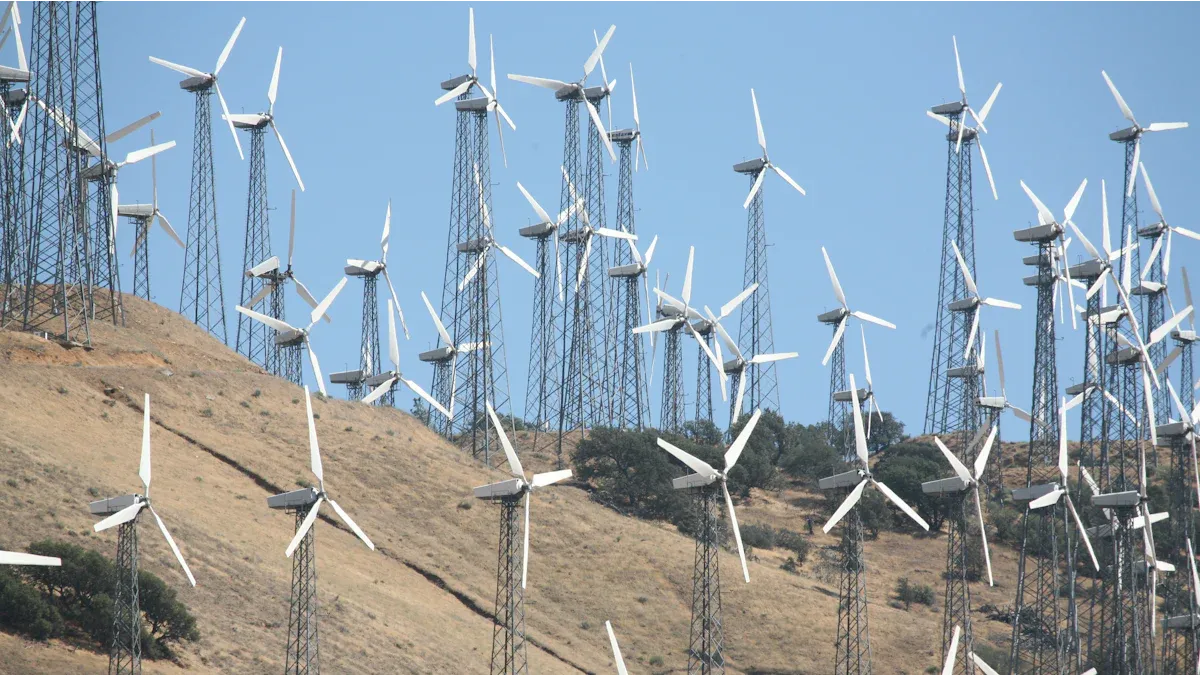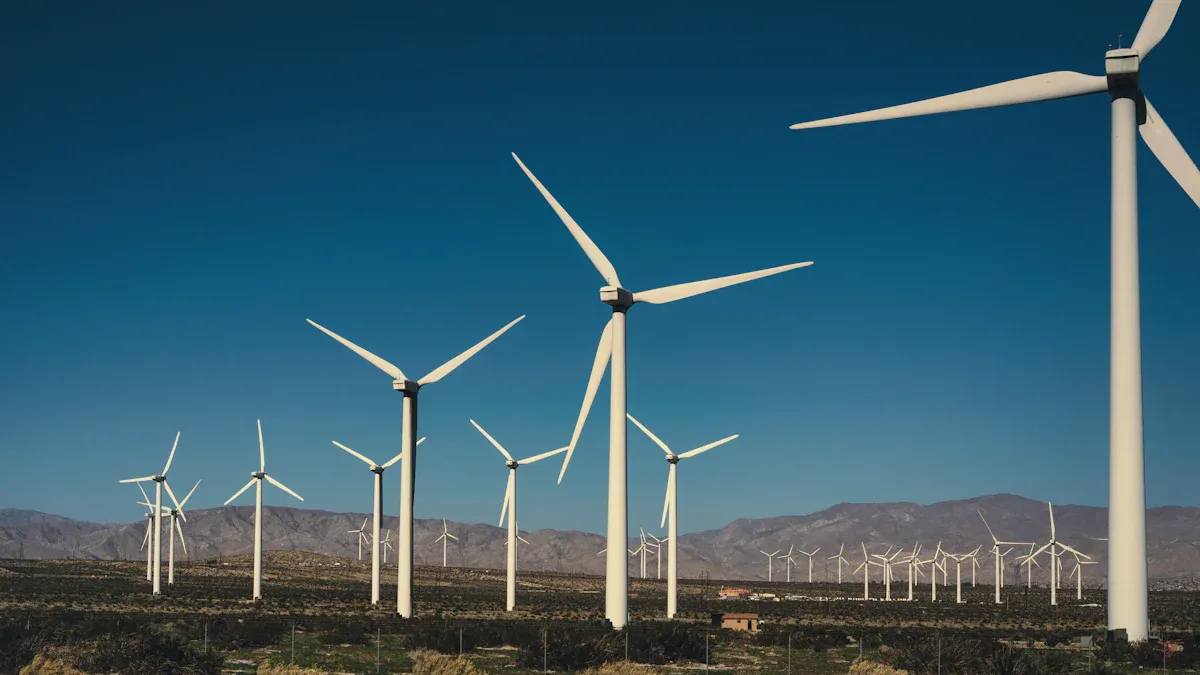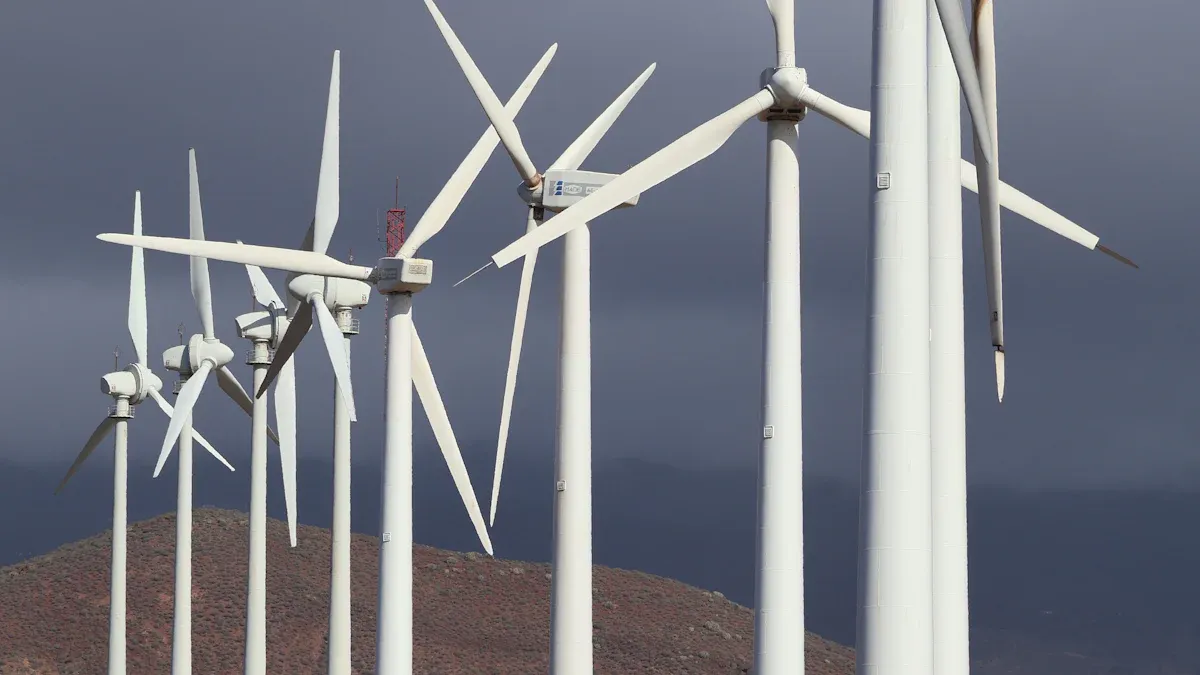
Vietnam’s wind energy sector has experienced remarkable growth in recent years. I see this expansion as a result of the country’s commitment to renewable energy and its vast offshore wind potential. By 2035, the offshore wind industry is expected to generate 700,000 full-time equivalent (FTE) employment years. Around 40% of these jobs will come from exporting components made locally. Forged Shafts in Vietnam’s wind turbines play a crucial role in ensuring reliability and efficiency. These components withstand extreme conditions, enhancing turbine performance and reducing downtime.
Key Takeaways
- Vietnam’s wind energy is growing fast, aiming for 19 GW by 2030. This will create many jobs and help the economy grow.
- Forged shafts are key parts of wind turbines. They help make energy efficiently and need less fixing, which makes them more reliable.
- New forging technology makes shafts stronger, better, and cheaper to use.
- Government rules and rewards encourage renewable energy, helping Vietnam compete in the world wind energy market.
- Solving supply problems and using new ideas will help Vietnam’s wind energy grow and meet future energy needs.
Vietnam’s Wind Energy Landscape

Growth Trends and Government Targets
Vietnam’s wind energy sector has grown rapidly in recent years. I see this as a result of the government’s ambitious targets and the country’s natural advantages. For example, Vietnam’s installed wind power capacity reached 4,596 MW by the end of 2022. The government aims to increase this capacity to 19 GW by 2030, contributing 14.5% to the total power capacity. By 2050, the target is even more ambitious, with plans to achieve between 60 GW and 77 GW of wind energy capacity.
The long coastline and mountainous regions provide ideal conditions for wind projects. Successful developments, such as the Bac Lieu Wind Farm and Trung Nam Wind Farm, showcase the sector’s potential. These projects highlight how Vietnam is leveraging its natural resources to meet its renewable energy goals. The government’s commitment to renewable energy, combined with international partnerships, has created a strong foundation for future growth.
Key Drivers of Wind Energy Expansion
Several factors drive the expansion of wind energy in Vietnam. First, technological advancements have made wind energy more affordable than fossil fuels. This cost competitiveness encourages investment. Second, Vietnam’s policies, such as PDP 8 and JETP, provide a supportive framework for renewable energy development. Generous feed-in tariffs, tax exemptions, and land lease payment reductions make the sector attractive to investors.
Corporate demand for clean energy also plays a significant role. Many companies now prioritize renewable energy sources, which boosts the demand for wind power. Additionally, investments in grid modernization ensure that the energy produced can be efficiently integrated into the national grid. These factors, combined with Vietnam’s economic advantages, position the country as a leader in renewable energy.
Role of Forged Shafts in Vietnam’s Wind Energy Sector
Forged shafts in Vietnam’s wind turbines are critical to the sector’s success. These components transmit rotational energy from the rotor to the generator, ensuring efficient energy production. As wind turbines grow larger, the demand for longer and sturdier shafts increases. For instance, turbines like the Haliade-X require advanced forged shafts to support their size and energy output.
The durability and reliability of forged shafts reduce maintenance needs and downtime. This enhances the overall performance of wind turbines. I believe that investing in innovative materials and forging techniques can further improve these components. By focusing on quality and performance, forged shafts in Vietnam’s wind energy sector will continue to play a vital role in meeting the country’s renewable energy goals.
Technical Overview of Forged Shafts in Vietnam’s Wind Sector

Manufacturing Process and Techniques
I find the manufacturing process of forged shafts fascinating due to its precision and complexity. The process begins with selecting high-quality raw materials, typically forged steel, known for its superior mechanical properties. Advanced forging techniques, such as free-die forging, are then employed to shape the shafts. These methods ensure the shafts can withstand the immense stresses of wind turbine operations.
Technological advancements have revolutionized this process. For example, the integration of digital monitoring systems allows manufacturers to track every stage of production. Predictive maintenance tools also help identify potential issues before they arise. Partnerships between manufacturers and research institutions have further driven innovation, leading to the development of smart materials and optimized designs. These advancements not only enhance the efficiency of the manufacturing process but also improve the performance of the final product.
Material Properties and Durability
The durability of forged shafts in Vietnam’s wind turbines depends heavily on the materials used. Forged steel is preferred over alternatives like nodular cast iron due to its exceptional strength and fatigue resistance. Studies show that chill casting technology, which produces smaller graphite nodules, significantly enhances fatigue strength. This makes the shafts more reliable under the cyclic loads experienced in wind turbines.
| Aspect | Details |
|---|---|
| Material Type | Forged steel materials are preferred over nodular cast iron due to superior mechanical properties. |
| Microstructure Impact | Chill casting technology results in smaller graphite nodules, enhancing fatigue strength. |
| Testing Methodology | Cyclic material behavior is investigated through component fatigue tests with strain measurements. |
| Design Optimization | A hollow rotor design shaft made of EN-GJS-400-18-LT chill cast is developed for better performance. |
| Environmental Considerations | Cast components can reduce CO2 emissions and energy consumption due to lower smelting temperatures. |
These material properties ensure that forged shafts can endure harsh environmental conditions, such as high winds and temperature fluctuations, without compromising performance.
Contribution to Wind Turbine Performance
Forged shafts play a pivotal role in the efficiency of wind turbines. They transmit rotational energy from the rotor to the generator, ensuring smooth and consistent energy production. As turbines grow larger, the demand for longer and sturdier shafts increases. This is where the durability and precision of forged shafts truly shine.
The wind turbine forging shafts market has significantly enhanced turbine performance. By reducing maintenance needs and minimizing downtime, these components contribute to the overall reliability of wind energy systems. I believe this reliability is crucial for the continued growth of Vietnam’s wind energy sector. With ongoing advancements in forging technology, the potential for even greater efficiency and performance is immense.
Challenges in Forged Shafts in Vietnam’s Wind Sector
Supply Chain and Sourcing Issues
I see supply chain challenges as a significant hurdle for forged shafts in Vietnam’s wind sector. Manufacturers face delays due to global disruptions, often caused by geopolitical tensions and pandemics. These disruptions increase costs and extend production timelines. For instance, sourcing high-quality materials like nitrided steel, which offers superior fatigue resistance, requires longer supplier qualification processes. These processes now take 35% more time because of the need to meet sustainability-driven standards.
Fluctuations in raw material costs, particularly steel and alloys, further complicate the situation. These price changes directly impact manufacturing expenses, making it harder for producers to maintain competitive pricing. Additionally, the growing demand for rotor shafts compatible with renewable energy systems adds pressure to the supply chain. I believe addressing these issues requires stronger partnerships between suppliers and manufacturers to ensure a steady flow of materials.
Quality Control and Standardization
Ensuring consistent quality in forged shafts is another challenge. Regulatory bodies now demand compliance with advanced energy efficiency standards, such as the EU’s Ecodesign Directive and the U.S. Department of Energy (DOE) requirements. These regulations push manufacturers to adopt innovative materials and designs, such as ultra-thin, low-loss electrical steel laminations. Procurement teams increasingly prioritize suppliers who meet these stringent criteria.
Blockchain-enabled material passports are becoming essential for verifying compliance. These digital records track the entire supply chain, ensuring materials meet recycled content thresholds and efficiency standards. Companies like Siemens Energy have already implemented blockchain technology, reducing compliance audit costs. I think this trend will continue to grow, helping manufacturers streamline quality control processes while meeting regulatory demands.
Cost and Economic Constraints
Economic constraints pose a significant challenge for the production of forged shafts. Energy-intensive forging processes tie manufacturing costs to volatile electricity and natural gas prices. For example, natural gas prices in the EU quadrupled in 2022, leading to higher production expenses. Supply chain bottlenecks, such as the Red Sea shipping crisis in 2024, extended lead times by 8-12 weeks, further straining budgets.
Demand volatility in the wind energy sector also impacts production. A 35% year-on-year growth in 2023 created order backlogs of up to 18 months. To mitigate these challenges, some companies are adopting vertical integration and blockchain-enabled tracking. These strategies help reduce vulnerabilities in the rotor shaft value chain. I believe that by embracing such innovations, manufacturers can better navigate economic constraints and maintain steady production.
Opportunities for Forged Shafts in Vietnam’s Wind Sector
Government Policies and Incentives
Vietnam’s government has created a supportive environment for renewable energy development. Policies like Decision No. 37/2011/QD-TTg encourage wind power projects by offering incentives and subsidies. These measures make wind energy investments more attractive. For example, tax exemptions and reduced land lease payments lower the financial burden for developers.
Globally, programs like the Production Tax Credit and Investment Tax Credit in the United States also promote wind energy. These initiatives indirectly benefit the forging market by increasing demand for wind turbine components.
| Evidence Type | Description |
|---|---|
| Government Policy | Supportive policies and subsidies encourage renewable energy investments. |
| Incentive Program | Tax credits and other incentives boost wind energy development worldwide. |
I believe these policies create a strong foundation for the growth of forged shafts in Vietnam’s wind sector. They not only stimulate domestic demand but also position Vietnam as a competitive player in the global market.
Advancements in Forging Technology
Technological advancements are transforming the forging industry. Automation and digitization, such as AI-powered quality control and IoT sensors, streamline operations and reduce material waste. These innovations improve efficiency and ensure consistent quality.
The emergence of high-strength alloys and superalloys allows for precision forging. This enables the creation of complex geometries without compromising structural integrity. I find it fascinating how smart forging presses, with capacities up to 16,000 tons, can produce single-piece rotor shafts. These advancements meet the growing demand for stronger and lighter components.
Collaborations with research institutions also drive innovation. For instance, partnerships with the Fraunhofer Institute focus on additive manufacturing for hybrid shafts. This leads to next-generation lightweight designs, enhancing turbine performance. I see these developments as key to meeting the evolving needs of the wind energy sector.
Vietnam’s Potential as a Regional Manufacturing Hub
Vietnam has the potential to become a regional leader in forged shaft manufacturing. The country’s renewable energy targets drive domestic demand. At the same time, its strategic location offers opportunities to export to Southeast Asia and beyond.
| Aspect | Details |
|---|---|
| Domestic Demand | Driven by Vietnam’s renewable energy goals. |
| Regional Hub Potential | Opportunities to export to neighboring countries. |
| Production Capacity | Increasing to meet both domestic and international needs. |
| Offshore Technology | Expansion into offshore wind turbine technology. |
Vietnam’s growing production capacity and technological advancements strengthen its position in the global market. I believe this growth will contribute to energy security and reduce wind power generation costs. By focusing on innovation and quality, Vietnam can solidify its role as a key player in the wind energy industry.
Forged Shafts in Vietnam’s wind energy sector remain vital for ensuring turbine reliability and efficiency. The industry faces challenges like fluctuating raw material costs, skilled labor shortages, and supply chain disruptions. However, opportunities abound, including advancements in materials, circular economy practices, and global market expansion.
| Aspect | Details |
|---|---|
| Market Size | Valued at USD 1.50 Billion in 2022, projected to reach USD 2.80 Billion by 2030, growing at a CAGR of 8.50% from 2024 to 2030. |
| Key Challenges | - Raw Material Costs: Fluctuations in prices of steel and alloys. |
| - Skilled Labor Shortage: Complicates production processes. | |
| Potential Growth Opportunities | - Innovation in Materials: Investment in alternative materials. |
| - Partnerships and Collaborations: Innovation through collaboration. |
I see Vietnam’s commitment to renewable energy and innovation as a driving force for future growth. By addressing challenges and leveraging opportunities, the sector can achieve sustainable development and global competitiveness.
FAQ
What are forged shafts, and why are they important in wind turbines?
Forged shafts are precision-engineered components made from high-strength materials like forged steel. They transfer rotational energy from the turbine’s rotor to its generator. Their durability ensures turbines operate efficiently, even under extreme conditions. Without them, turbines would face frequent breakdowns and reduced energy output.
How does Vietnam benefit from manufacturing forged shafts locally?
Local production reduces reliance on imports, lowering costs and boosting the economy. It also creates jobs and positions Vietnam as a regional leader in renewable energy manufacturing. By producing high-quality forged shafts, Vietnam can meet domestic demand and export to neighboring countries.
What materials are commonly used for forged shafts?
Manufacturers primarily use forged steel due to its exceptional strength and fatigue resistance. Advanced alloys and superalloys are also gaining popularity. These materials ensure the shafts can withstand high stress and harsh environmental conditions, making them ideal for large wind turbines.
How do advancements in forging technology impact the wind energy sector?
Technological innovations like AI-powered quality control and IoT sensors improve manufacturing precision. These advancements reduce material waste and enhance the performance of forged shafts. As a result, turbines become more efficient, reliable, and cost-effective, supporting the growth of wind energy.
Can Vietnam become a global hub for forged shaft production?
Absolutely! Vietnam’s strategic location, renewable energy goals, and growing manufacturing capacity make it a strong contender. By investing in advanced forging technologies and maintaining high-quality standards, Vietnam can compete globally and contribute significantly to the wind energy supply chain.
Post time: Mar-31-2025



